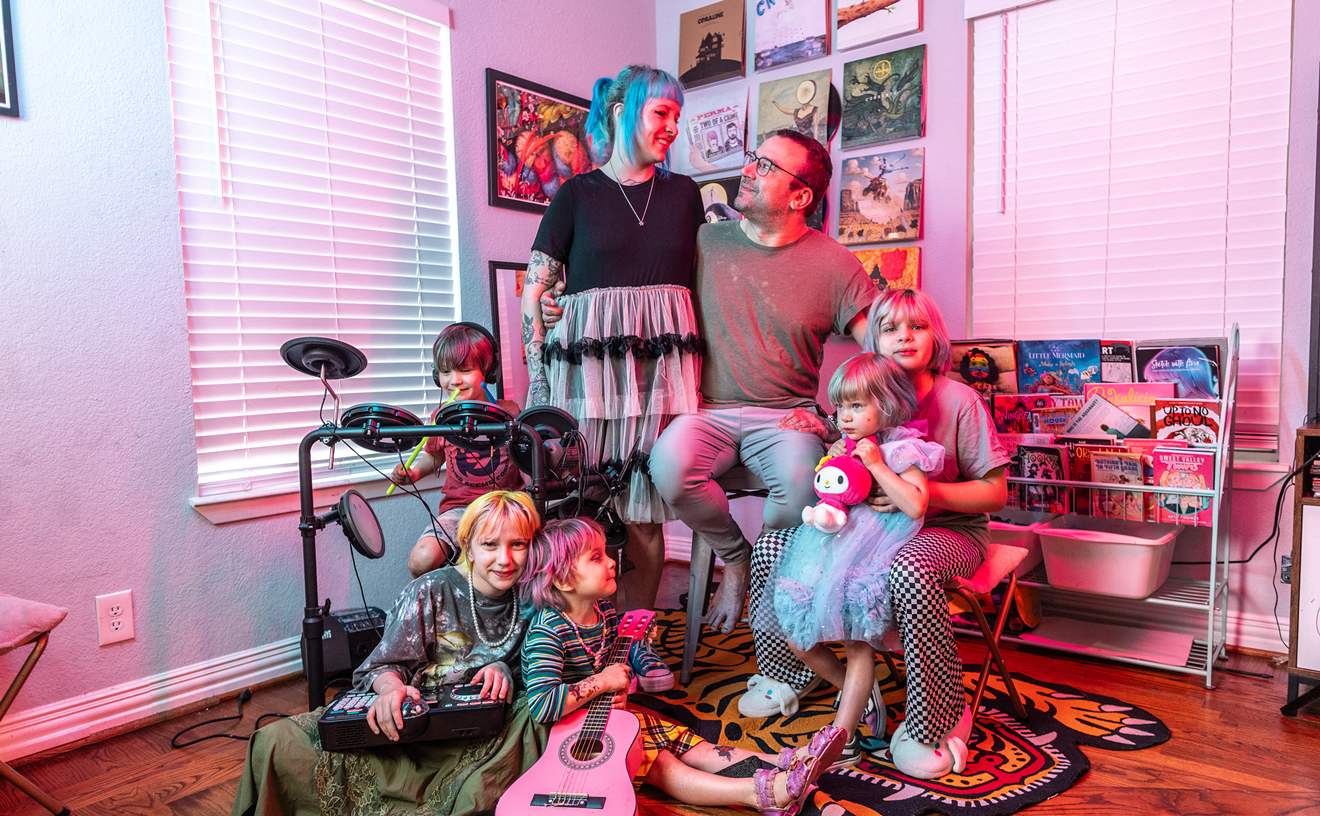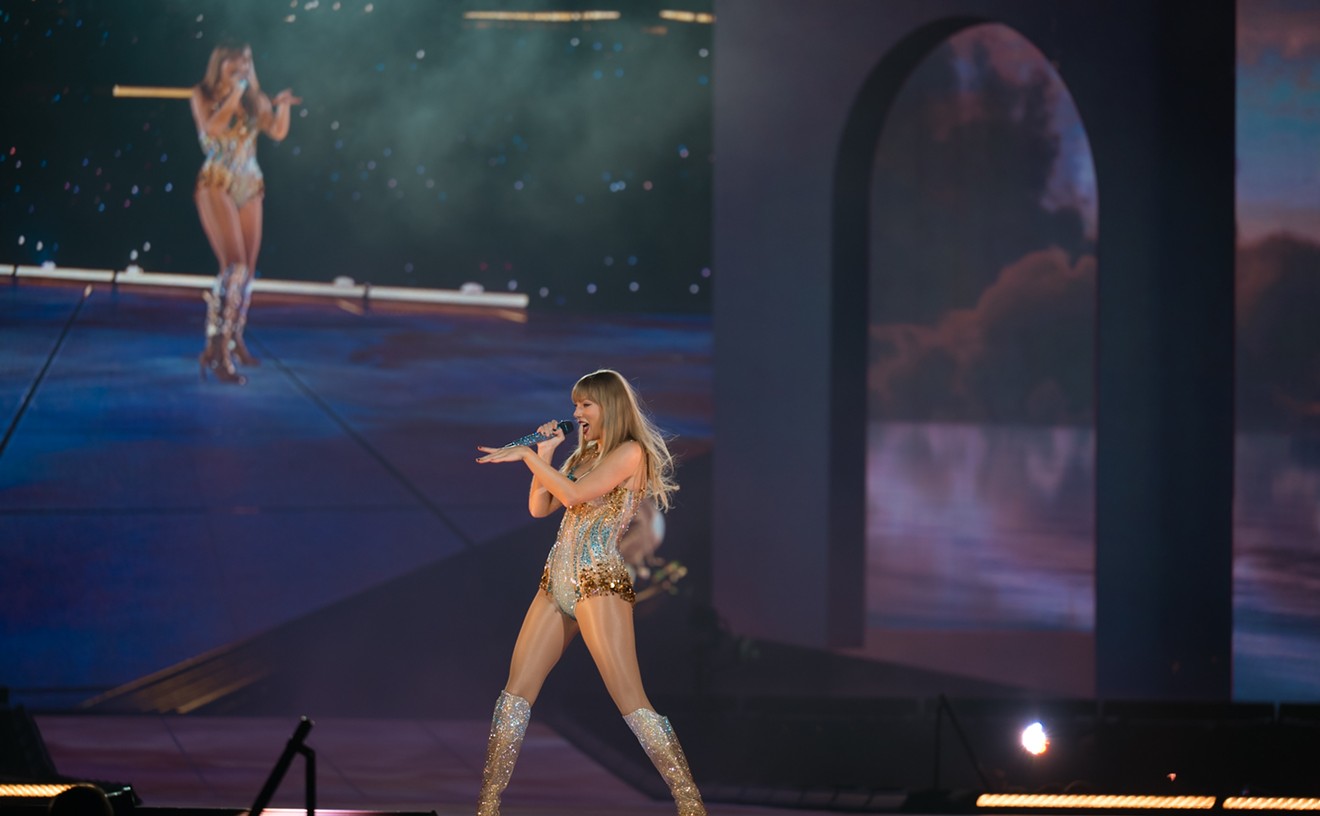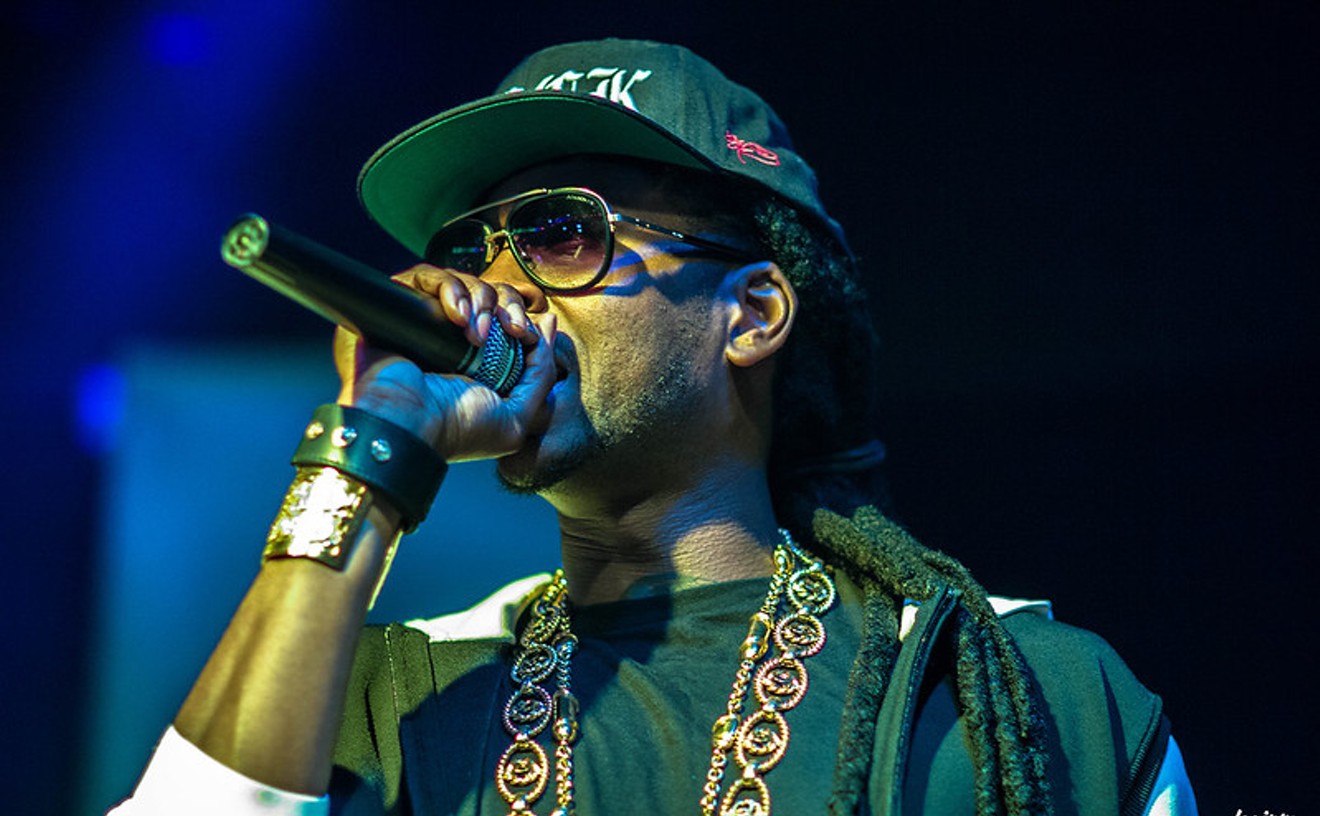It's not until he picks up his banjo--its juxtaposition of polished wood, heavy steel, and finely drawn wire mirroring the strength and delicacy it takes to play it--that it really seems likely that this man, this Light Crust Doughboy, has kept the wellspring of Western swing running clear almost since it began to flow.
"We're the ones who started it," Montgomery says matter-of-factly, his sentiment neither prideful nor falsely modest. "We didn't know what we were doing at the time--that's just how it turned out. But we had a lot of amazing talent in the Doughboys, guys like Knocky Parker and Zeke Campbell, and we listened to everything."
In his pursuit of "everything," Montgomery has heard Leadbelly sing in Deep Ellum and stood on stage with Elvis. Montgomery is much like the music he plays: Both are mutable entities formed by their surroundings, and they carry the past in their altered shapes, submitting it to the present and presenting it to the future.
Bob Wills, the hero of Western swing, is frozen in memory; Milton Brown and His Musical Brownies, with far less renown though possibly more talent, are equally trapped. Only the Light Crust Doughboys are still around and still playing. The band's 65-year history makes it the world's longest-running country act, and Montgomery was around for most of it.
The Light Crust Doughboys was actually started by Brown and Wills in 1931. The two convinced Ft. Worth's Burrus Mill and Elevator Company to sponsor a radio show featuring them and guitarist Herman Arnspiger. Burrus president W. Lee "Pappy" O'Daniel didn't much care for the band's "hillbilly" music: He'd tried to can them after a fortnight, only to have an outraged public successfully petition for their return.
O'Daniel, Burrus' star salesman before he was made president, knew what to do when confronted with a demand: Meet it. His skill at what would now be called networking got the Doughboys on his Texas Quality Network, which consisted of more than 170 radio stations, mainly in Oklahoma and Texas. The band started selling--Wills' very first recorded "aah-haa!" was on the Doughboys' "Sunbonnet Sue"--and before long, was a sensation.
The Doughboys made such an impression that O'Daniel's successful 1939 bid for the Texas governorship can in part be credited to his stint as the band's announcer, even though he left the band in 1935. (The Doughboys were never associated with his campaign. Rather, O'Daniel hired former Doughboys to perform for him at various campaign rallies, though the perception the real Boys did O'Daniel's bidding remains.)
Brown left in '32, and Wills' drinking earned him the boot a year later. No doubt O'Daniel's less-than-enlightened managerial style played a part in their departures: He referred to his musicians by such nicknames as Snub and Bashful to prevent them from taking off on their own.
At the same time, a banjo-playing college boy named Marvin Montgomery was using his musical skills to see the country beyond his hometown of Ames, Iowa, with a traveling show. He found himself in Victoria, Texas, with plenty of time to think.
"I had been making $11 a week for a year and a half, paying for my own meals and everything," Montgomery recalls. "I had to get away from that tent show!" When a position for a guitar player came up in Dallas, paying a princely $3 per gig, Montgomery took his savings, a whole $29, and lit out for the big city, where he got in on a trio called the Wanderers that was regularly playing live on WFAA-AM.
With the Wanderers, Montgomery crossed paths with Milton Brown. The Wanderers performed at competitive "battle dances" with Brown's band around Dallas and in the booming oil fields around Kilgore and Gladewater. When announcer-manager Eddie Dunn revamped the Doughboys' lineup in 1935, he added the three Wanderers to the roster, and Montgomery got another chance to become involved with one of Brown's creations, signing on as the Doughboys' tenor banjo player. He's been there ever since.
Although Wills and Brown had drawn the fiddle-band template that the Doughboys would follow into the '90s, there were significant differences between the Doughboys and the music Wills and Brown went off to become famous for.
"They were more [like] dance bands," Montgomery says. "They put more pop, more Cab Calloway, into things. We didn't play that many dances or clubs. We were more of a show, with an MC and all. We did more cowboy songs, like 'Red River Valley' and Sons of the Pioneers stuff, and we did a hymn on every show."
Denied the distractions of honky-tonks because of Burrus' requirement of a squeaky-clean image, the Doughboys emphasized showmanship. Rubber-faced fiddler Carroll Hubbard had a routine during "Chicken Reel" in which he realistically feigned a surprised chicken laying an egg, an act that culminated in the egg--hard-boiled for handling--being tossed into the crowd. It was a favorite with audiences until someone substituted a raw egg.
The Doughboys' sound was different then, as well. Montgomery played a tenor banjo--not the long-necked five-string type familiar to bluegrass fans, but a shorter four-stringed model that was once played on the riverboats and in the dance halls of Dixieland. The instruments' trebly chop made up for the lack of drums.
"Too much equipment," Montgomery says, explaining those drumless days. "Cars in those days, you'd tie the bass fiddle on the roof, and there wasn't any room for anything else." The all-string lineup kept the Doughboys a bit closer to their acoustic heritage, and their three-part singing style reminded the listener of their gospel roots. There were rural, even Appalachian, undertones to their sound.
Yokels, however, they were not. The Doughboys embodied the cross-pollination of ragtime, swing, jazz, and country and western just as completely as their better-known cohorts. "We'd listen to a lot of Benny Goodman and Tommy Dorsey," Montgomery recalls, "looking for tricks." The blues were filtering in there, too: Band members would find an area's "colored" clubs and sit in, learning such new techniques as string-bending. Band members also visited the still-bustling Deep Ellum scene, picking up on the stylistic innovations of such artists as pianist Clarence "Pinetop" Smith.
The '30s was the Doughboys golden age, both for fame and chops. They went to Hollywood and made two movies with Gene Autry, The Big Show and Oh Susanna. In the latter, the Doughboys play two numbers beneath paper lanterns, and the speed of their chops is as amazing as the enormous Tom Mix-style sombreros they're wearing.
During this period the Doughboys toured the country in a $50,000 custom bus that had its own generator-powered PA and a covered stage on the back; on the sides, the words "Light Crust Doughboys" were painted in red neon. It looked like a cross between a Tijuana taxicab and a gazebo with wheels, and it made quite an impression in dusty burgs that might only have had one radio; with it the Boys could draw three times a town's population. It also made quite an impression on new Doughboy recruits, who were advised to urinate off the back of the moving bus to save time. The bus' unique aerodynamic properties usually went unmentioned: They caused anything thrown off the tail to be hurled back into the face of the thrower.
The Doughboys took a break for World War II, and when they reformed in 1946, Montgomery was the only prewar name that came back. America's tastes had changed during the war, however, and the new radio show never reached its old heights. The advent of TV spelled the end, and the Light Crust Doughboys went off the air in 1951.
They continued to tour, and the band was not above keeping in step with the times. Before the war, when Wills and Brown began enjoying widespread success, the Doughboys--in their hearts and souls a string band--moved closer to their sound by adding a piano player. After the war, they experimented with different singers--among them Hank Thompson, Tennessee Ernie Ford, and Slim Whitman--and in the mid-'50s met the growing tide of Elvismania with an Elvis of their own: Dallas' own "Blond Bomber," the great Ronnie Dawson.
"We both knew each other," Dawson recalls. (In fact, Montgomery and the other Doughboys knew Dawson's dad, local bass-fiddle player Pinkie Dawson.) "We played this big concert down on Commerce, with flatbed trucks lining the streets and all these bands using them for stages. [Montgomery] approached me about going out on the road with him. Later on he told me, 'The reason I noticed you is that when you were playing people stopped what they were doing.'"
Although Dawson now recalls his tenure with pride, the rocking 16-year-old Bomber was less than impressed.
"There wasn't a lot of glamour to it," says Dawson. "Back then, fiddles were uncool--completely--and Western swing was dead." Recognizing steady paying work when he saw it, however, Dawson became a Doughboy. His hopes of working his square gig in anonymity were dashed almost immediately when Montgomery came to pick him up in a mammoth station wagon with "WHITE CRUST DOUGHBOYS" painted on the side. At the very least, Dawson had a ringside seat for the band's slow decline.
"The only audience we had were grocery stores and schools, and that was a bummer for me--I wanted to play for some people!" Dawson recalls. "You had to get up at 7 [a.m.] and go do a radio show or a store at 8. People didn't want to hear music at 9 in the morning while they were shopping, especially hillbilly music. It wasn't hillbilly music, man, it was jazz, but that's how they looked at it...I wasn't too into that."
Shoppers may have disliked the string band, but the kids loved Dawson. Montgomery says audiences would give him a hard time about bringing Dawson--"this kid," Smokey says--to shows, but that once they heard him and saw him play, they'd have no more doubts.
"Sure enough, Ronnie would do an Elvis song and just get mobbed by these kids," Montgomery recalls, "and when we left, the same folks would be saying, 'You be sure to bring that blonde kid back!'" Dawson kept at it, playing rock licks on his Stratocaster while the band played along behind him, turning standards like "Red River Valley" into teen-friendly songs like "Red River Rock."
"It was the hardest gig I ever played," Dawson recalls with obvious fondness. "It wasn't until 10 or 15 years ago, when I started studying the music of the '30s and '40s, that I understood the way it all came together in Texas music and Western swing, and I realized what I'd been a part of."
By the '60s the changing face of pop left the Doughboys all but forgotten, still relegated to playing stores that bought enough flour from Burrus to rate a visit. It was a trend that continued through the '80s, but things changed in 1993 when Art Greenhaw joined the band as bassist.
"I'm lucky I play so many instruments because bass was the only opening they had," says Greenhaw, a music lover whose Mesquite hardware store is perhaps the only place you can buy a pickaxe and a 12-string Rickenbacker guitar. Greenhaw appreciated the historical significance of the Doughboys, and his enthusiasm for the band has ushered in a "silver age" of renewed appreciation.
"People are paying more attention to us now than they have in years," Montgomery says. The band has released four albums since '93 and is the subject of an hour-long video documentary by Oklahoma documentarian Gary Don Rhodes. The significance of the group appealed to Rhodes, who directed and wrote Texas Swing: A Memoir of Music, Politics & the Light Crust Doughboys.
Rhodes grew up listening to Western swing, and even as a kid he understood the appeal of importance of the Doughboys. He recalls listening to the band on the radio with his grandfather, and his dad took him to see the band in the early 1980s. "They're literally the living roots of the music I love," he says, "and nobody has ever really explored them historically, even though the guys are still on the road, still available for interviews."
Well-made and informative, the video seeks to set things right by affording a deep peek into the band, guided by interviews and some teasingly--perhaps even maddeningly--fuzzy film footage. The way in which the history of the Doughboys reflects broader cultural currents is sometimes startling: Who else can you name who's played with Gene Autry and for LBJ?
Recently the band released a three-CD box set of the "silver age" material put out since 1993, and the compilation reflects a band that has once again changed. Horns and reeds have been added, and now there is even a Doughgirl, vocalist Jamie Shipman. Greenhaw has devoted a corner of his hardware store to his Texas Western Swing and Light Crust Doughboys Hall of Fame and Museum, a collection of photos and memorabilia documenting Western swing and the Doughboys.
Things are indeed looking up, but the work of preserving the Doughboy's history is by no means through. Although the Greenhaw-era releases have put the Doughboys before a younger and newer audience, the songs are all contemporary versions of old standards and favorites, done as "tributes" to the milestones in the band's career. Although none would dispute the Doughboys' right to do any song they please, such misguided covers as "Yesterday" and "Jailhouse Rock" don't work as well as the old stuff.
The band's original 78s and acetate recordings--more than 200 albums and singles' worth in all--still haven't been collected or even studied like those of Bob Wills and Milton Brown. Until that has been done, the memory of the Lightcrust Doughboys--and that hard-scrabble, Dust Bowl part of ourselves driving a Model T into town to hear some music--will be imperfectly preserved.
Scene, heard
The second-annual BarleyPalooza goes down this Sunday from noon until 2 p.m. in the rear parking lots of the Barley House at 2916 N. Henderson. The 14-hour music fest was a hit last year, and this year's lineup--featuring Slobberbone, Cowboys and Indians, the Buena Vistas, the Nitrons, Homer Henderson, the Sutcliffes, the Calways, and Slinky--looks even better. Buddy Hickerson, creator of the "Quigmans" comic strip, and Q102 (KTXQ-FM) mainstay Redbeard will MC the event, but come anyway...
Break out the olives: Reverend Horton Heat's second Interscope album, It's Martini Time, will be released July 2...
The ashes of Funland aren't yet cool, but drummer Will Johnson's one-man project the Centromatic Band will be playing an in-store set at 7 p.m. on May 30 at Last Beat's record store on Elm Street. It's an "official" record-release party for the seven-inch The Transistor EP, which is being released by the Granbury-based way-indie label Automatic Records.
Street Beat welcomes e-mail tips and comments at [email protected].










